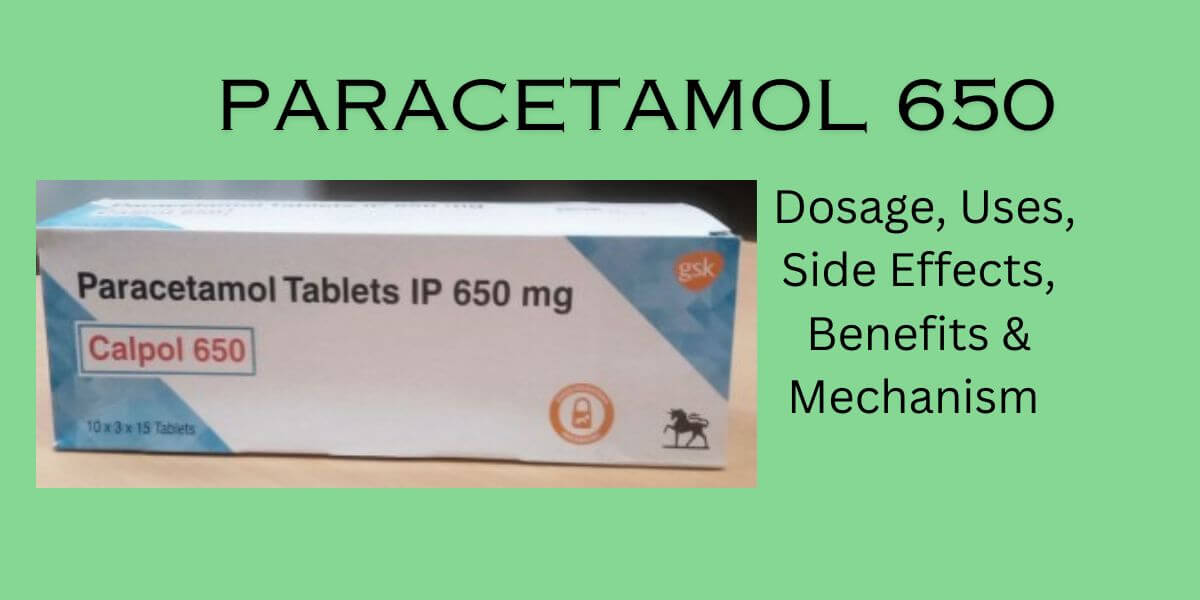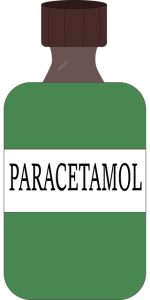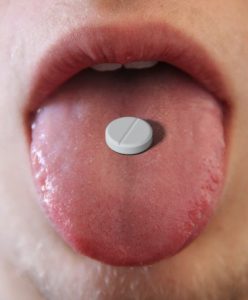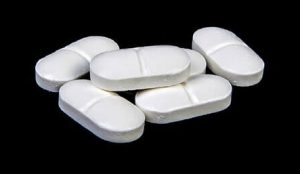The Ultimate Guide to Paracetamol 650: Dosage, Uses, and Benefits
 Posted On
Posted On
Contents
- Introduction
- What is paracetamol 650 mg used for?
- How does paracetamol work in our body?
- What are the side effects of paracetamol 650 mg?
- How much paracetamol is a serious overdose?
- What is the difference between paracetamol 650 and 500 mg tablet?
- How much paracetamol 650 can be taken in 24 hours?
- How long does paracetamol take to work?
- Can I take paracetamol 650 with NSAIDs?
- Conclusion
- FAQ
Introduction
Whenever you get a fever, you seek a paracetamol medicine. Today, we will discuss paracetamol 650, which is most prominent with the names Dolo 650, Calpol 650, Crocin 650, Paracip 650 and so on.
Paracetamol is an OTC (over-the-counter) or non-prescription medicine. You may get this medicine at any pharmacy store without a doctor’s prescription.
We all know that a fever, headaches and body pain sometimes can get in the way of living a healthy life.
Paracetamol 650 mg is a highly efficacious antipyretic medicine if compared with paracetamol 500 mg.
This medicine does not only relieve fever but is also effective in body pain such as headache, migraine, toothache, backache, etc.
This article will explore paracetamol 650 uses, benefits, side effects, dosage, mechanism, pharmacokinetics and contraindications.
Let the article be started.
What is paracetamol 650 mg used for?
The “paracetamol” word is derived from the para-aminophenol group. This means the paracetamol structure contains a hydroxyl group (OH), an amide group (HN-CO-R), and an aromatic group (benzene ring). It is often known as “acetaminophen.”

Paracetamol or acetaminophen has two important properties – antipyretic (to reduce fever) and mild analgesic (pain reliever).
This drug doesn’t work if you have inflammation (like rheumatoid arthritis).
The Paracetamol 650 does not have anti-inflammatory activity because it has a negligible effect on the COX enzyme (cyclooxygenase) in the peripheral. So, paracetamol is not considered an NSAID (Non-steroidal Anti-inflammatory drug).
Due to the lack of anti-inflammatory activity, paracetamol (or acetaminophen) is only used to reduce the increased body temperature and pain relief such as –
- Headache
- Mild migraine
- Muscle pain
- Sprains
- Toothache
- Dysmenorrhoea
- Musculoskeletal conditions, such as osteoarthritis and backache

In children, paracetamol is one of the best antipyretic drugs. It can also be prescribed for the elderly, whose age is more than 60 years.
Many professional bodies recommend paracetamol as the first line of treatment for osteoarthritis.
How does paracetamol work in our body?
Have you ever thought about what happens when you take paracetamol?
Let me make you understand how paracetamol travels in your body (pharmacokinetic) and how your body responds against paracetamol (mechanism of action).
When you take paracetamol, it enters your stomach. After taking paracetamol, it disintegrates and then dissolves. After that, it rapidly absorbs from the small intestine of the duodenum and enters your blood circulation.

Paracetamol is almost well distributed to the entire tissues of your body.
The mechanism of action of paracetamol is described by blocking the formation of prostaglandin. It works in your brain.
Paracetamol rapidly crosses your blood-brain barrier because it is a highly lipid-soluble drug.
When paracetamol enters your brain, it stops prostaglandin production by inhibiting COX-2 (Cyclo-oxygenase).
After providing the therapeutic effect, this medicine goes to your liver for metabolism.
Your liver starts the glucuronidation reaction of paracetamol. In this glucuronidation, paracetamol gets conjugated with glucuronic acid and sulfuric acid.
This glucuronidation process makes the paracetamol inactive; as a result, it forms inactive metabolites – paracetamol glucuronidated or sulphated.
These inactive metabolites (paracetamol glucuronidated or sulphated) are water-soluble compounds. They are easily eliminated from the kidney.
This process enhances the excretion of the inactive metabolite of paracetamol (water-soluble) through urine.
What are the side effects of paracetamol 650 mg?
Paracetamol is generally considered safe when taken as directed. However, like all medication, paracetamol can have side effects –
Common side effects
The right dosage of paracetamol rarely causes side effects.
Uncommon side effects
You may have nausea, vomiting, abdominal pain and liver tenderness during paracetamol therapy.
Rare side effects
You might have life-threatening side effects of paracetamol but it rarely happens when you take it in overdose (> 150 mg/kg or > 10 g in an adult) or longtime. It might cause –
- Allergic reactions such as itchy, lumpy rash (hives) or urticaria.
- Anaphylactic shock (swelling of the hands, feet, ankles, face, lips or throat which may cause difficulty in swallowing or breathing)
- Blood problems (such as agranulocytosis, neutropenia or thrombocytopenia).
- Liver damage such as Jaundice, hepatitis, etc.
How much paracetamol is a serious overdose?
The overdose of paracetamol 650 mg can be very serious and potentially life-threatening.
You will be shocked to know that paracetamol toxicity is the second leading cause of liver transplantation globally.
The maximum dose of paracetamol per day for adults is 4 g (or 4000 mg).

Taking more than the recommended dose of paracetamol can lead to overdose, which can cause serious liver damage or even be fatal.
Paracetamol is itself a toxic drug because it forms a minor toxic metabolite – NAPQI (N-acetyl benzoiminoquinone) in your liver.
This NAPQI is a highly reactive and potentially dangerous metabolite of paracetamol.
NAPQI is mainly responsible for liver damage.
Fortunately, acetaminophen medication is metabolized by the glucuronidation process. Glucuronidation is an important process of metabolism because it helps in detoxifying the NAPQI metabolite.
What is the difference between paracetamol 650 and 500 mg tablet?
The main difference between paracetamol 650 mg and 500 mg tablets is the dosage of the active ingredient. Both the medicines have same active ingredient, which is paracetamol.
The choice between the two strengths depends on individual needs, severity of symptoms, and healthcare provider recommendations.
The 650 mg tablet may be suitable for individuals who require a higher dose of paracetamol to achieve adequate pain relief or fever reduction.
| Paracetamol 650 mg | Paracetamol 500 mg | |
| Dosage | The 650 mg tablet contains 650 milligrams of paracetamol | The 500 mg tablet contains 500 milligrams of paracetamol. |
| Potency | More potent | Less potent |
| Efficacy | High efficacy | Less efficacy |
| Pain relief | Work effectively to relieve pain and fever (Good analgesic) | Does not work properly to relieve pain (Mild analgesic) but has a good efficacy for fever. |
How much paracetamol 650 can be taken in 24 hours?
The maximum recommended daily dose of paracetamol for adults is typically around 4000 milligrams (4 grams) per day, although this can vary depending on individual factors, severity of symptoms and underlying health conditions.
However, it is recommended not to take more than four tablets of paracetamol 650 in a day or 24 hours.
You should stop taking medicine once you get relief from pain and fever.
You need to swallow whole tablet with a full glass of water. You can take this medicine with or without food.
How long does paracetamol take to work?
The maximum paracetamol concentration reaches your blood within 20 minutes when you are on an empty stomach.
If you take paracetamol after a meal, it takes 60 minutes to reach maximum blood concentration.
Overall, the onset of action of paracetamol is 30 min.
Paracetamol drug remains in your blood for up to 3 to 4 hours because the half-life of paracetamol is 2 hours.
Can I take paracetamol 650 with NSAIDs?
If you are not getting pain relief from paracetamol 650 mg. Then, you can take paracetamol with NSAID medications. NSAIDs are painkillers that relieve headache, muscle, and body pain. It includes aceclofenac, diclofenac, ibuprofen, naproxen, etc.
When paracetamol is taken with NSAIDs, it gives a synergetic effect.
You can easily get popular combinations of Paracetamol and NSAIDs, such as
- Ibuprofen and Paracetamol tablet (Combiflam tablet)
- Diclofenac sodium and paracetamol tablet (Diclofam plus, Dynapar)
- aceclofenac and paracetamol tablet (Aceclo plus, Zerodol P)
Conclusion
The paracetamol 650 is a go-to medicine for fever and pain relief.
This medicine is an absolutely safe, effective, and well-tolerated medicine when you take it in the appropriate and recommended dose.
For specific guidance on the use of paracetamol or any drug, always seek the advice of a healthcare provider.
If you find this post informative, please share it on social media.
FAQ
Q1. Can I take paracetamol 650 without fever?
Yes, you can take paracetamol 650 mg even if you don’t have a fever. It also works in body pain.
Q2. How many paracetamol 650 can we take in a day?
You can up to 4 tablets of paracetamol 650 mg every 6 hours in a day.
Q3. Is paracetamol and dolo same?
The Dolo is a brand name, which contains paracetamol. So, paracetamol and dolo are the same medicine.
Q4. What is the best tablet for a fever?
The best tablet for fever depends on various factors, including the severity of the fever, individual health conditions, and personal preferences. However, paracetamol, often known as acetaminophen, is frequently regarded as one of the most popular and efficient drugs for lowering fever and easing related symptoms.
Q5. Can paracetamol be taken during pregnancy?
Generally, paracetamol is considered safe for use during pregnancy when taken at recommended doses. Due to its extensive research and long history of safe usage, it is frequently advised as the first-line treatment for fever and discomfort during pregnancy.
Q6. Can I drive if I have consumed the Dolo 650 tablet?
Paracetamol does not cause any drowsiness, sleep or impairment. So, you can drive the vehicle after consuming Dolo (paracetamol) 650.


